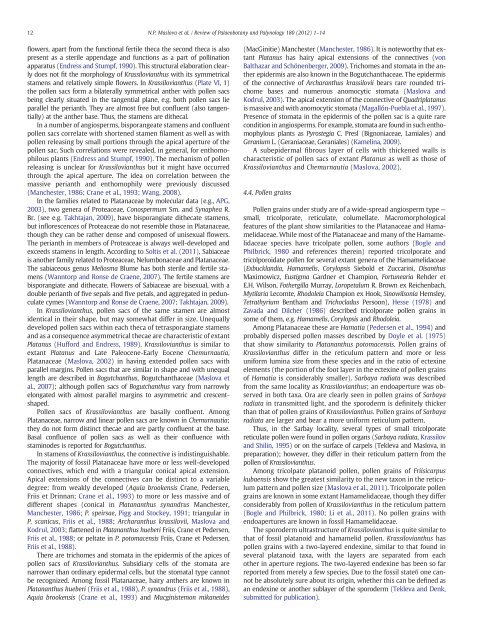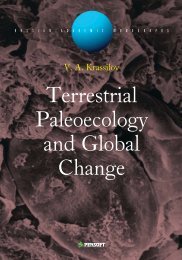Krassilovianthus gen. nov., a new staminate inflorescence with ...
Krassilovianthus gen. nov., a new staminate inflorescence with ...
Krassilovianthus gen. nov., a new staminate inflorescence with ...
You also want an ePaper? Increase the reach of your titles
YUMPU automatically turns print PDFs into web optimized ePapers that Google loves.
12 N.P. Maslova et al. / Review of Palaeobotany and Palynology 180 (2012) 1–14<br />
flowers, apart from the functional fertile theca the second theca is also<br />
present as a sterile appendage and functions as a part of pollination<br />
apparatus (Endress and Stumpf, 1990). This structural elaboration clearly<br />
does not fit the morphology of <strong>Krassilovianthus</strong> <strong>with</strong> its symmetrical<br />
stamens and relatively simple flowers. In <strong>Krassilovianthus</strong> (Plate VI, 1)<br />
the pollen sacs form a bilaterally symmetrical anther <strong>with</strong> pollen sacs<br />
being clearly situated in the tan<strong>gen</strong>tial plane, e.g. both pollen sacs lie<br />
parallel the perianth. They are almost free but confluent (also tan<strong>gen</strong>tially)<br />
at the anther base. Thus, the stamens are dithecal.<br />
In a number of angiosperms, bisporangeate stamens and confluent<br />
pollen sacs correlate <strong>with</strong> shortened stamen filament as well as <strong>with</strong><br />
pollen releasing by small portions through the apical aperture of the<br />
pollen sac. Such correlations were revealed, in <strong>gen</strong>eral, for enthomophilous<br />
plants (Endress and Stumpf, 1990). The mechanism of pollen<br />
releasing is unclear for <strong>Krassilovianthus</strong> but it might have occurred<br />
through the apical aperture. The idea on correlation between the<br />
massive perianth and enthomophily were previously discussed<br />
(Manchester, 1986; Crane et al., 1993; Wang, 2008).<br />
In the families related to Platanaceae by molecular data (e.g., APG,<br />
2003), two <strong>gen</strong>era of Proteaceae, Conospermum Sm. and Synaphea R.<br />
Br. (see e.g. Takhtajan, 2009), have bisporangiate dithecate stamens,<br />
but <strong>inflorescence</strong>s of Proteaceae do not resemble those in Platanaceae,<br />
though they can be rather dense and composed of unisexual flowers.<br />
The perianth in members of Proteaceae is always well-developed and<br />
exceeds stamens in length. According to Soltis et al. (2011), Sabiaceae<br />
is another family related to Proteaceae, Nelumbonaceae and Platanaceae.<br />
The sabiaceous <strong>gen</strong>us Meliosma Blumehasbothsterileandfertilestamens<br />
(Wanntorp and Ronse de Craene, 2007). The fertile stamens are<br />
bisporangiate and dithecate. Flowers of Sabiaceae are bisexual, <strong>with</strong> a<br />
double perianth of five sepals and five petals, and aggregated in pedunculate<br />
cymes (Wanntorp and Ronse de Craene, 2007; Takhtajan, 2009).<br />
In <strong>Krassilovianthus</strong>, pollen sacs of the same stamen are almost<br />
identical in their shape, but may somewhat differ in size. Unequally<br />
developed pollen sacs <strong>with</strong>in each theca of tetrasporangiate stamens<br />
and as a consequence asymmetrical thecae are characteristic of extant<br />
Platanus (Hufford and Endress, 1989). <strong>Krassilovianthus</strong> is similar to<br />
extant Platanus and Late Paleocene-Early Eocene Chemurnautia,<br />
Platanaceae (Maslova, 2002) in having extended pollen sacs <strong>with</strong><br />
parallel margins. Pollen sacs that are similar in shape and <strong>with</strong> unequal<br />
length are described in Bogutchanthus, Bogutchanthaceae(Maslova et<br />
al., 2007); although pollen sacs of Bogutchanthus vary from narrowly<br />
elongated <strong>with</strong> almost parallel margins to asymmetric and crescentshaped.<br />
Pollen sacs of <strong>Krassilovianthus</strong> are basally confluent. Among<br />
Platanaceae, narrow and linear pollen sacs are known in Chemurnautia;<br />
they do not form distinct thecae and are partly confluent at the base.<br />
Basal confluence of pollen sacs as well as their confluence <strong>with</strong><br />
staminodes is reported for Bogutchanthus.<br />
In stamens of <strong>Krassilovianthus</strong>, the connective is indistinguishable.<br />
The majority of fossil Platanaceae have more or less well-developed<br />
connectives, which end <strong>with</strong> a triangular conical apical extension.<br />
Apical extensions of the connectives can be distinct to a variable<br />
degree: from weakly developed (Aquia brookensis Crane, Pedersen,<br />
Friis et Drinnan; Crane et al., 1993) to more or less massive and of<br />
different shapes (conical in Platananthus synandrus Manchester,<br />
Manchester, 1986; P. speirsae, Pigg and Stockey, 1991; triangular in<br />
P. scanicus, Friis et al., 1988; Archaranthus krassilovii, Maslova and<br />
Kodrul, 2003; flattened in Platananthus hueberi Friis, Crane et Pedersen,<br />
Friis et al., 1988; orpeltateinP. potomacensis Friis, Crane et Pedersen,<br />
Friis et al., 1988).<br />
There are trichomes and stomata in the epidermis of the apices of<br />
pollen sacs of <strong>Krassilovianthus</strong>. Subsidiary cells of the stomata are<br />
narrower than ordinary epidermal cells, but the stomatal type cannot<br />
be recognized. Among fossil Platanaceae, hairy anthers are known in<br />
Platananthus hueberi (Friis et al., 1988), P. synandrus (Friis et al., 1988),<br />
Aquia brookensis (Crane et al., 1993) andMacginistemon mikaneides<br />
(MacGinitie) Manchester (Manchester, 1986). It is noteworthy that extant<br />
Platanus has hairy apical extensions of the connectives (von<br />
Balthazar and Schönenberger, 2009). Trichomes and stomata in the anther<br />
epidermis are also known in the Bogutchanthaceae. The epidermis<br />
oftheconnectiveofArcharanthus krassilovii bears rare rounded trichome<br />
bases and numerous anomocytic stomata (Maslova and<br />
Kodrul, 2003). The apical extension of the connective of Quadriplatanus<br />
is massive and <strong>with</strong> anomocytic stomata (Magallón-Puebla et al., 1997).<br />
Presence of stomata in the epidermis of the pollen sac is a quite rare<br />
condition in angiosperms. For example, stomata are found in such enthomophylousplantsasPyrostegia<br />
C. Presl (Bignoniaceae, Lamiales) and<br />
Geranium L. (Geraniаceae, Geraniales) (Kamelina, 2009).<br />
Asubepidermalfibrous layer of cells <strong>with</strong> thickened walls is<br />
characteristic of pollen sacs of extant Platanus as well as those of<br />
<strong>Krassilovianthus</strong> and Chemurnautia (Maslova, 2002).<br />
4.4. Pollen grains<br />
Pollen grains under study are of a wide-spread angiosperm type —<br />
small, tricolporate, reticulate, columellate. Macromorphological<br />
features of the plant show similarities to the Platanaceae and Hamamelidaceae.<br />
While most of the Platanaceae and many of the Hamamelidaceae<br />
species have tricolpate pollen, some authors (Bogle and<br />
Philbrick, 1980 and references therein) reported tricolporate and<br />
tricolporoidate pollen for several extant <strong>gen</strong>era of the Hamamelidaceae<br />
(Exbucklandia, Hamamelis, Corylopsis Siebold et Zuccarini, Disanthus<br />
Maximowicz, Eustigma Gardner et Champion, Fortunearia Rehder et<br />
E.H. Wilson, Fothergilla Murray, Loropetalum R. Brown ex Reichenbach,<br />
Mytilaria Lecomte, Rhodoleia Champion ex Hook, Sinowilsonia Hemsley,<br />
Tetrathyrium Bentham and Trichocladus Persoon), Hesse (1978) and<br />
Zavada and Dilcher (1986) described tricolporate pollen grains in<br />
some of them, e.g. Hamamelis, Corylopsis and Rhodoleia.<br />
Among Platanaceae these are Hamatia (Pedersen et al., 1994) and<br />
probably dispersed pollen masses described by Doyle et al. (1975)<br />
that show similarity to Platananthus potomacensis. Pollen grains of<br />
<strong>Krassilovianthus</strong> differ in the reticulum pattern and more or less<br />
uniform lumina size from these species and in the ratio of ectexine<br />
elements (the portion of the foot layer in the ectexine of pollen grains<br />
of Hamatia is considerably smaller). Sarbaya radiata was described<br />
from the same locality as <strong>Krassilovianthus</strong>; an endoaperture was observed<br />
in both taxa. Ora are clearly seen in pollen grains of Sarbaya<br />
radiata in transmitted light, and the sporoderm is definitely thicker<br />
than that of pollen grains of <strong>Krassilovianthus</strong>. Pollen grains of Sarbaya<br />
radiata are larger and bear a more uniform reticulum pattern.<br />
Thus, in the Sarbay locality, several types of small tricolporate<br />
reticulate pollen were found in pollen organs (Sarbaya radiata, Krassilov<br />
and Shilin, 1995) or on the surface of carpels (Tekleva and Maslova, in<br />
preparation); however, they differ in their reticulum pattern from the<br />
pollen of <strong>Krassilovianthus</strong>.<br />
Among tricolpate platanoid pollen, pollen grains of Friisicarpus<br />
kubaensis show the greatest similarity to the <strong>new</strong> taxon in the reticulum<br />
pattern and pollen size (Maslova et al., 2011). Tricolporate pollen<br />
grains are known in some extant Hamamelidaceae, though they differ<br />
considerably from pollen of <strong>Krassilovianthus</strong> in the reticulum pattern<br />
(Bogle and Philbrick, 1980; Li et al., 2011). No pollen grains <strong>with</strong><br />
endoapertures are known in fossil Hamamelidaceae.<br />
The sporoderm ultrastructure of <strong>Krassilovianthus</strong> is quite similar to<br />
that of fossil platanoid and hamamelid pollen. <strong>Krassilovianthus</strong> has<br />
pollen grains <strong>with</strong> a two-layered endexine, similar to that found in<br />
several platanoid taxa, <strong>with</strong> the layers are separated from each<br />
other in aperture regions. The two-layered endexine has been so far<br />
reported from merely a few species. Due to the fossil stateб one cannot<br />
be absolutely sure about its origin, whether this can be defined as<br />
an endexine or another sublayer of the sporoderm (Tekleva and Denk,<br />
submitted for publication).

















